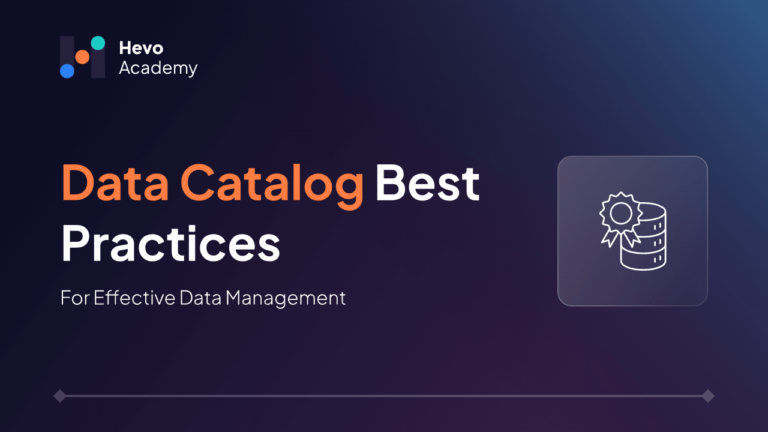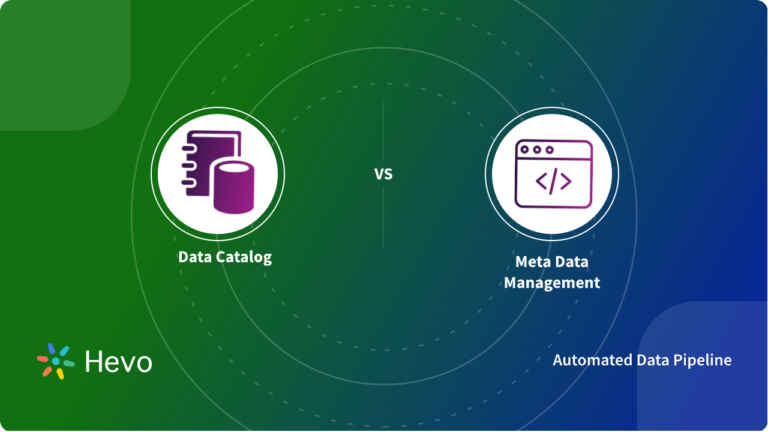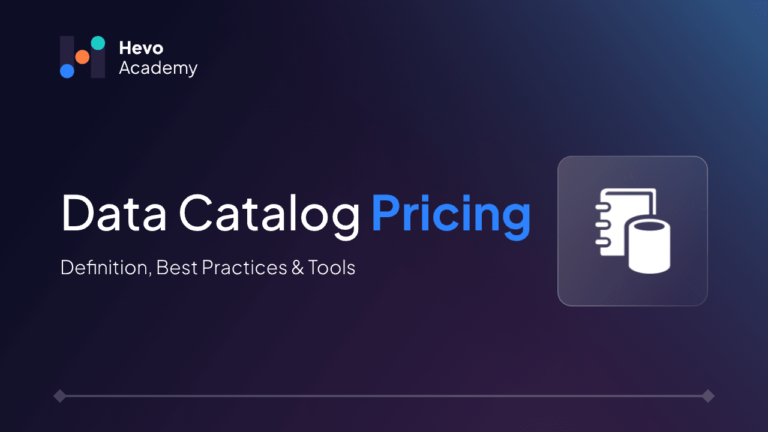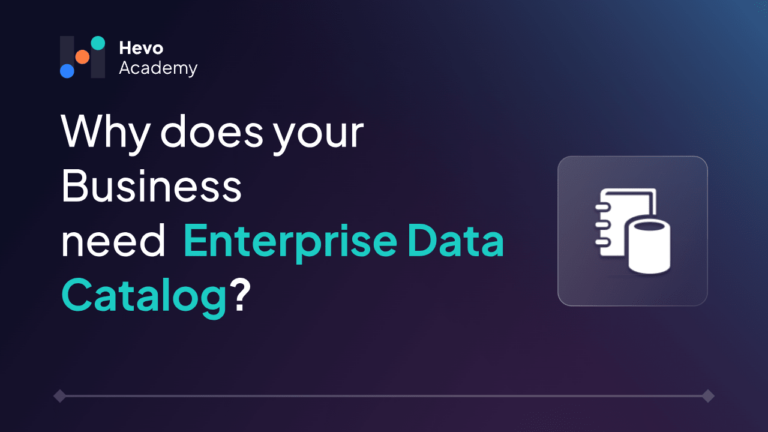Understanding the Importance of a Data Catalog
Organizations often struggle with:
Table of Contents
- Accessing and integrating data scattered across different systems and departments.
- Making quick decisions and operating efficiently, as a lot of time and resources are wasted searching for data.
- Maintaining compliance and data quality due to a lack of oversight and control over data.
Implementing data catalog best practices helps organizations manage and utilize their data more efficiently by systematically cataloging all data assets, improving data accessibility, and supporting compliance with data regulations and policies. This helps: data is organized, easily accessible, and handled according to legal standards. To learn more you can check out this blog on data catalog.
What is a Data Catalog?
A data catalog is like a detailed map for all the data in an organization. It helps you locate and understand different data sets by providing details about each data asset, such as where it is, who owns it, and how it can be used. It offers metadata management, data lineage, governance policies, and many more features. For instance, Google Cloud Data Catalog is a tool that helps users quickly discover and manage their data on Google Cloud Platform.
Why Your Business Needs a Data Catalog?
As organizations grow, so does their data. With a data catalog in place:
- Your team can save time and resources by quickly finding and accessing the data they need, which increases efficiency.
- You can gain a competitive edge by accessing data faster and more accurately, enhancing your decision-making.
- Teams can also collaborate better, as a data catalog makes sharing and working with data across different departments easier.
All of this is crucial for keeping your business efficient, streamlined, and competitive.
Looking for the best ETL tools to connect your data sources? Rest assured, Hevo’s no-code platform helps streamline your ETL process. Try Hevo and equip your team to:
- Integrate data from 150+ sources(60+ free sources).
- Utilize drag-and-drop and custom Python script features to transform your data.
- Risk management and security framework for cloud-based systems with SOC2 Compliance.
Try Hevo and discover why 2000+ customers have chosen Hevo over tools like AWS DMS to upgrade to a modern data stack.
Get Started with Hevo for FreeKey Components of a Successful Data Catalog
Data is the single source of truth for any organization. If not managed properly, it can lead to significant issues such as data quality and accuracy problems, where inaccurate or outdated data results in poor decision-making and loss of trust in the data.
By following data catalog best practices, you can ensure proper implementation and awareness of key components for a successful data catalog.
Three key components include:
- Data Discovery and Classification: Identify and categorize your data assets.
- Metadata Management: Handle data about data, including its source and format.
- Data Lineage and Governance: Track the origin and movement of your data
1. Data Discovery and Classification
You start by identifying and categorizing all data assets within the organization. This makes it easier to locate and utilize relevant data.
How to implement it?
- Use tools that automatically scan and classify data across various sources.
- Apply consistent tags and labels to data assets for easy identification.
- Encourage data stewards and users to contribute to the classification process.
Pro-Tip: Regularly update your data inventory to ensure all new data is captured and classified.
2. Metadata Management
Build and handle data about your data, such as its source, format, and usage. This improves data understanding and usability with consistent documentation and accessible information.
How to implement it?
- Maintain a centralized repository for all metadata. But ensure the repository is accessible, scalable, and properly governed.
- Metadata is standardized across the organization.
- Use automated tools to capture and update metadata.
Pro Tip: Implement a metadata management tool that integrates with your existing data systems.
3. Data Lineage and Governance
Data lineage tracks data origin, transformations, and movement, while governance ensures data quality and compliance. This maintains trust and reliability in data-driven decisions.
How to implement it?
- Use tools that automatically capture and visualize data lineage.
- Set a governance framework with clear policies and procedures.
- Conduct regular audits to ensure compliance and data quality.
Pro Tip: Visualize data lineage to quickly identify and resolve data quality issues.
Tools and Technologies for Data Cataloging
A right data cataloging tool must bridge the gap between flexibility and cost savings or advanced features and support. This section will help you understand the pros and cons of open-source and commercial solutions, empowering you to select the best tool for your data strategy.
Open-Source vs. Commercial Solutions
| Factor | Apache Atlas (Open Source) | Alation (Commercial) |
| Cost | Free | Subscription-based |
| Customization | Highly customizable | Limited customization |
| Support | Community support | Professional support available |
| Ease of Use | Steeper learning curve | User-friendly interface |
| Integration | Integrates well with Hadoop | Integrates with various data sources |
| Features | Basic features, extensible | Advanced features, AI-driven |
| Scalability | Scalable with effort | Enterprise-grade scalability |
| Security | Basic security features | Robust security and compliance |
| Documentation | Extensive but technical | Comprehensive and user-friendly |
| Updates | Community-driven, less frequent | Regular updates and improvements |
| User Feedback | Preferred by tech-savvy users | Praised for ease of use and support |
| User Insights | ★★★☆☆ | ★★★★★ |
Best Practices for Building and Maintaining a Data Catalog
A well-implemented data catalog significantly improves data governance, data quality, and data management efficiency. Adhering to data catalog best practices maximizes the benefits of a data catalog.
While the specifics may vary depending on your data architecture, integrating a data catalog—whether it’s a legacy system or a newly migrated one—optimizes your data system beyond mere cost savings.
Some data catalog best practices are:
1. Start with Clear Objectives
To improve data discoverability, enhance data governance, and boost data quality, start by clearly defining your goals for the data catalog. Identify specific use cases and the value they will bring to your organization. Involve data scientists, analysts, business users, and IT teams to ensure proper alignment and adoption.
Set specific, measurable goals. For example, aim to reduce the time spent searching for data by 50% within six months. Clear objectives help prioritize efforts and resources, ensuring your data catalog delivers maximum value.
2. Involve Stakeholders Early
From the very beginning, engage all relevant stakeholders, including data stewards, analysts, and business users, through workshops and meetings. This clarifies the data catalog’s benefits and gathers input to ensure everyone understands them. Early involvement fosters a sense of ownership and ensures the data catalog meets the needs of all users, leading to higher adoption rates. Establish governance by dividing roles and responsibilities for data ownership, stewardship, and catalog maintenance.
3. Automate Metadata Collection
To ensure your data catalog is always up-to-date and accurate, automate metadata collection. Use tools, scripts, and technologies to automate the collection of metadata from various sources, including databases, data warehouses, and cloud platforms. Automation reduces manual effort and errors, making your data catalog a reliable resource. Additionally, data quality checks should be implemented to ensure the accuracy and reliability of the catalog’s metadata.
4. Ensure Continuous Data Quality Monitoring
To ensure your data catalog remains reliable and accurate, it’s crucial to continuously monitor data quality and promptly address any issues. By tracking the flow of data from source to target systems, you can identify potential problems and maintain data integrity. Utilizing advanced tools that offer validation rules, anomaly detection, and machine learning-based predictions can help spot and prevent quality issues. It’s not just about tracking data but proactively preventing issues through automation.
Promptly mitigate any issues identified through data quality checks and alerts. Perform periodic audits to assess the catalog’s effectiveness and identify areas for improvement. Regular monitoring helps maintain high data quality, enabling businesses to make informed decisions.
You can check out how to build a data catalog step-by-step to easily manage your organization’s data.
Common Challenges and How to Overcome Them
While data catalogs are increasingly recognized as essential tools for data governance and decision-making, their implementation and maintenance can still present challenges. To fully realize the benefits of a data catalog, organizations must address issues such as data quality and scalability.
Below, we explore common challenges and offer strategies to overcome them. This will ensure that your data catalog best practices remain a valuable asset for your organization.
1. Handling Data Silos
Data silos occur when different departments or systems keep their data separate, making it hard for others to access. This can be due to old systems, company structure, or lack of data rules.
a. Identifying Data Silos
Recognizing the presence of data silos often involves observing these signs:
- Different departments may hold contradictory information about the same entities.
- Difficulty in obtaining data from other teams can significantly impact workflows.
- The existence of redundant information across various systems can lead to inefficiencies and errors.
b. Overcoming Data Silos
Addressing data silos with steps such as:
- Conduct periodic assessments to identify inconsistencies, redundancies, and data quality issues.
- Engage with teams to understand their data needs, challenges, and concerns.
- Implement ETL (Extract, Transform, Load) processes to consolidate data from different sources into a centralized repository.
- Foster a culture of data sharing and collaboration among departments to break down barriers.
- Establish clear guidelines for data standards, access, and usage to ensure consistency and security.
Quick-Tip:
- Regularly review and update data governance policies.
- Encourage a culture of collaboration and transparency.
- Invest in scalable and flexible data integration technologies.
2. Ensuring User Adoption
Users might not use the data catalog if they find it hard to use, don’t understand it, or prefer old methods. Diving deeper, users may feel overwhelmed by the system’s complexity if proper training is absent. A confusing interface or unclear functionalities can discourage users. Additionally, shifting from established methods to a new system can be met with resistance.
a. Identifying User Adoption Issues
To understand how your team is adopting the data catalog, observe the following signs:
- Minimal interaction with the data catalog suggests user reluctance.
- Users may express difficulty using the system through direct feedback or continued reliance on old methods.
- Users bypassing the data catalog can lead to outdated or inconsistent information circulating within the organization.
b. Overcoming User Adoption Issues
Addressing user adoption issues such as:
- Offer interactive training sessions tailored to user needs. Create clear and concise documentation for ongoing reference.
- Prioritize a user-friendly design that is simple to navigate and understand.
- Actively solicit user feedback on the data catalog’s functionalities and usability. Implement improvements based on their suggestions. This fosters a sense of ownership and engagement.
Quick-Tip:
- Continuously update training materials and provide ongoing support.
- Regularly engage with users to understand their needs and challenges.
- Highlight success stories and the benefits of using the data catalog.
3. Managing Data Security and Compliance
Security and compliance issues can arise from weak access controls, lack of encryption, or not following regulations. Diving deeper, inadequate permissions can grant unauthorized access to sensitive data. Without proper encryption, sensitive data may be vulnerable to breaches. Additionally, failure to adhere to industry-specific regulations (e.g., GDPR, HIPAA) can lead to legal and financial penalties.
a. Identifying User Adoption Issues
To understand how your team is adopting, observe the following:
- Unusual or suspicious activity, such as unauthorized data downloads or login attempts, indicates a security breach.
- A confirmed data breach, whether internal or external, is a clear sign of a security vulnerability.
- Fines, legal actions, or reputational damage resulting from non-compliance are indicative of underlying issues.
b. Overcoming User Adoption Issues
Addressing user adoption issues such as:
- Implement robust security measures such as encryption, access controls, and regular security audits to protect data.
- Stay updated with relevant regulations (e.g., GDPR, CCPA) and ensure the data catalog meets these requirements.
- Track data lineage and maintain audit logs to monitor data access and usage.
Quick-Tip:
- Regularly review and update security policies and procedures.
- Conduct periodic training on data security and compliance for all employees.
- Automated tools are used to monitor and enforce compliance continuously.
Conclusion
Integrating a data catalog into your organization results in: improved data governance, streamline decision-making, and improve data accessibility. By centralizing data, you ensure that everyone has access to the same, up-to-date information, which reduces redundancy and inconsistencies.
To further optimize, following data catalog best practices help identify data gaps and improve overall data quality.
- From the outset, define what you want to achieve with your data catalog.
- Engage key stakeholders in the planning and implementation phases to ensure the catalog meets their needs.
- Use automation to gather and update metadata, reducing manual effort and errors.
- Regularly monitor data quality to maintain the integrity and reliability of your data catalog.
However, one must not overlook the challenges and should actively work to mitigate them, as discussed in the article above. By addressing issues like data silos, user adoption, and data security, you can ensure that your data catalog remains a valuable asset for your organization.
Given the complexity of implementing a data catalog and following best practices, you might feel overwhelmed by the intricacies of your organization’s data. That’s where Hevo Data experts come in. They can help you strategize, plan, and navigate which data catalog best practices suit your organization’s needs, enabling you to make informed decisions. Connect with us to expedite your data management journey in the modern data era.
FAQ on Data Catalog Best Practices
1. How do you maintain a data catalog?
Regularly monitor data quality and update metadata to reflect any changes. Implement data governance practices to ensure consistency and reliability.
2. How do you structure a data catalog?
Organize the catalog by data domains and categories. Include detailed metadata, data lineage, and quality metrics for each dataset to provide comprehensive insights.
3. What is included in a data catalog?
A data catalog typically includes metadata, data lineage, data quality metrics, access permissions, and usage statistics. These elements help users understand and manage the data effectively.
4. Which are the two capabilities of a data catalog?
A data catalog facilitates data discovery, allowing users to easily find and access data. It also enhances data governance by managing metadata and ensuring data compliance.





